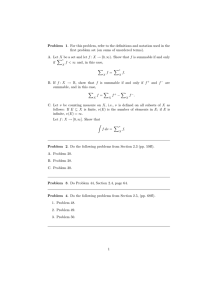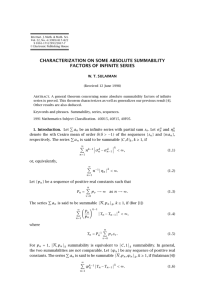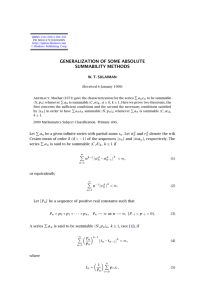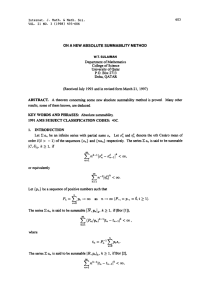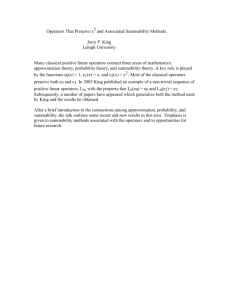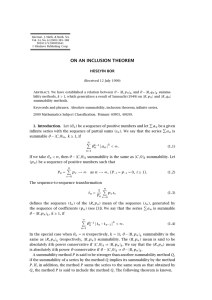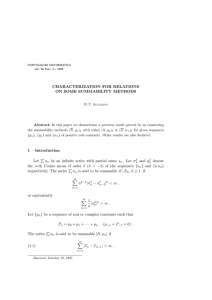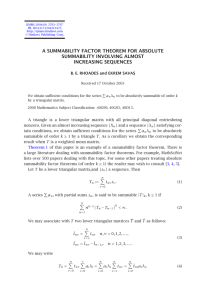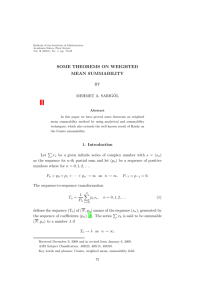A GENERALIZATION THEOREM COVERING MANY ABSOLUTE SUMMABILITY METHODS W. T. SULAIMAN
advertisement
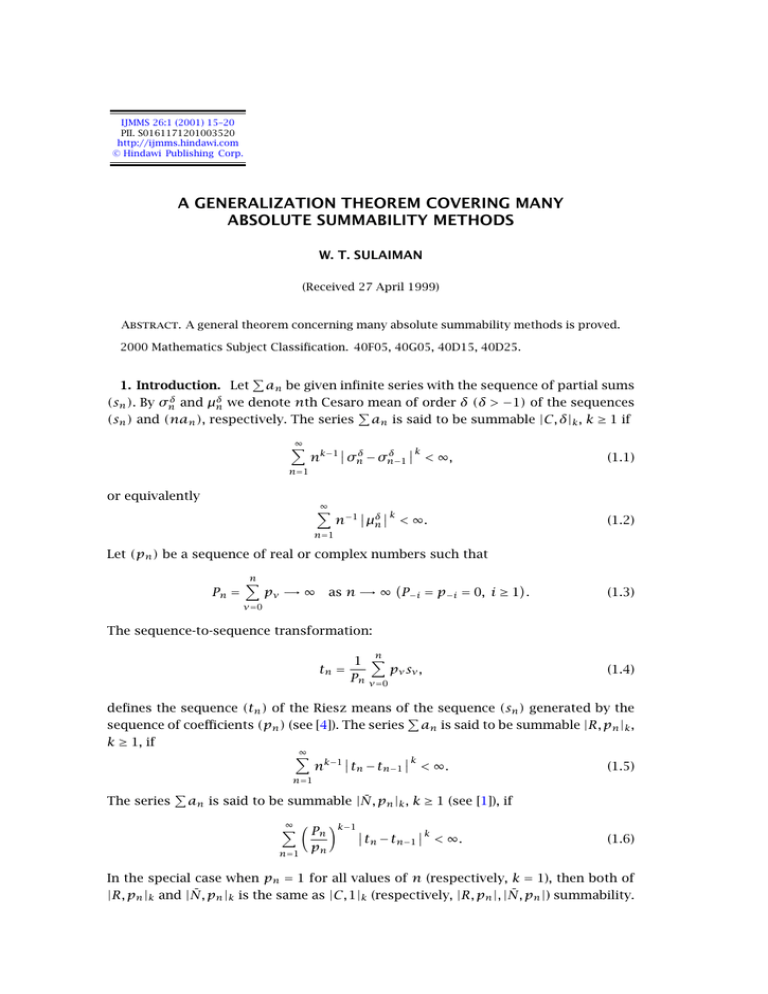
IJMMS 26:1 (2001) 15–20
PII. S0161171201003520
http://ijmms.hindawi.com
© Hindawi Publishing Corp.
A GENERALIZATION THEOREM COVERING MANY
ABSOLUTE SUMMABILITY METHODS
W. T. SULAIMAN
(Received 27 April 1999)
Abstract. A general theorem concerning many absolute summability methods is proved.
2000 Mathematics Subject Classification. 40F05, 40G05, 40D15, 40D25.
1. Introduction. Let an be given infinite series with the sequence of partial sums
δ
(sn ). By σnδ and µn
we denote nth Cesaro mean of order δ (δ > −1) of the sequences
(sn ) and (nan ), respectively. The series an is said to be summable |C, δ|k , k ≥ 1 if
∞
n=1
δ k
nk−1 σnδ − σn−1
< ∞,
or equivalently
∞
n=1
δ k
< ∞.
n−1 µn
(1.1)
(1.2)
Let (pn ) be a sequence of real or complex numbers such that
Pn =
n
pν → ∞
as n → ∞ P−i = p−i = 0, i ≥ 1 .
(1.3)
ν=0
The sequence-to-sequence transformation:
tn =
n
1 pν s ν ,
Pn ν=0
(1.4)
defines the sequence (tn ) of the Riesz means of the sequence (sn ) generated by the
sequence of coefficients (pn ) (see [4]). The series an is said to be summable |R, pn |k ,
k ≥ 1, if
∞
k
nk−1 tn − tn−1 < ∞.
(1.5)
The series
n=1
an is said to be summable |N̄, pn |k , k ≥ 1 (see [1]), if
∞ Pn k−1 tn − tn−1 k < ∞.
pn
n=1
(1.6)
In the special case when pn = 1 for all values of n (respectively, k = 1), then both of
|R, pn |k and |N̄, pn |k is the same as |C, 1|k (respectively, |R, pn |, |N̄, pn |) summability.
16
W. T. SULAIMAN
For pn = 1/(n + 1), the summability |N̄, pn |k is equivalent to |R, log n, 1|k . The series
an is said to be summable |N, pn |, if
∞
Tn − Tn−1 < ∞,
(1.7)
n=1
where
Tn =
n
1 pn−ν sν
Pn ν=0
T−1 = 0 .
(1.8)
We write p = {pn } and
pn+1
pn+2
M = p : pn > 0 and
≤
≤ 1, n = 0, 1, . . . .
pn
pn+1
(1.9)
It is known that for p ∈ M, equation (1.7) holds if and only if (see [3])
n
1 pn−ν νaν < ∞.
nPn ν=1
n=1
∞
For p ∈ M, the series
(1.10)
an is said to be summable |N, pn |k , k ≥ 1 (see [5]), if
∞
n=1
n
k
1 p
νa
n−ν
ν < ∞.
k
nPn
(1.11)
ν=1
In the special case in which pn = Arn−1 , r > −1, where Arn is the coefficient of x n in
the power series of (1 − x)−r −1 , for |x| < 1, |N, pn |k summability reduces to |C, r |k
summability, and for pn = 1/(n + 1), |N, pn |k is equivalent to |N, 1/(n + 1)|k summability. We assume that (fn ), (gn ), (Gn ), and (Hn ) are positive sequences.
2. Main result. We prove the following theorem.
Theorem 2.1. Let
Yn =
such that
Fn =
n
1
n
Fn−1 Hn
ν=1
fν → ∞,
f ∈ M,
νfn−ν xν "ν
Xn =
ν=1
n
1 gν xν .
Gn ν=1
(2.1)
(2.2)
Suppose that {nGn "n /Fn gn Hn } is monotonic and
gn+1 = O gn ,
gn+1
,
n
g n Hn
gn Hn
=O
,
nGn
nGn Fn+1
m
1
fn−ν
=
O
.
k
Hνk
n=ν+1 Fn−1 Hn
∆gn = O
(2.3)
(2.4)
(2.5)
(2.6)
17
A GENERALIZATION THEOREM COVERING MANY . . .
Then necessary and sufficient conditions that
(i) "n = O(Fn gn Hn /nGn ),
(ii) ∆"n = O(gn+1 Hn /nGn ).
|Yn |k < ∞ whenever
|Xn |k < ∞ are
3. Lemmas
Lemma 3.1 (see [2]). Let k ≥ 1, and let A = (anν ) be an infinite matrix. In order that
A ∈ (&k ; &k ) it is necessary that
anν = O(1)
(all n, ν).
(3.1)
Lemma 3.2 (see [6]). Let p ∈ M. Then for 0 < r ≤ 1,
∞
pn−ν−1
= O ν −r .
r
n Pn−1
n=ν+1
(3.2)
Lemma 3.3. Suppose that "n = O(fn gn ), fn , gn ≥ 0, {"n /fn gn } monotonic, gn =
O(1), and fn = O(fn /gn+1 ). Then "n = O(fn ).
Proof. Let kn = "n /fn gn = O(1). If (kn ) is nondecreasing, then
"n = kn fn gn − kn+1 fn+1 gn+1 ≤ kn fn gn − kn fn+1 gn+1
= kn fn gn = kn fn gn + gn+1 fn ,
"n = O fn gn + O gn+1 fn = O fn + O fn = O fn .
(3.3)
If (kn ) is nonincreasing, write ∇fn = fn+1 − fn ,
∇"n = kn+1 fn+1 gn+1 − kn fn gn ≤ kn ∇ fn gn
= kn fn ∇gn + gn+1 ∇fn ,
"n = ∇"n = O fn ∇gn + O gn+1 ∇fn = O fn ∇gn + O gn+1 fn = O f n + O fn = O f n .
(3.4)
4. Proof of Theorem 2.1
Sufficiency. We have via Abel’s transformation:
Yn =
=
=
fn−ν
g ν xν ν
"ν
Fn−1 Hn ν=1
gν
1
1
Fn−1 Hn
n
n−1
ν=1
1
n−1
Fn−1 Hn
ν=1
ν
gr xr ν
r =1
Gν Xν
n
fn−ν
f
0
"ν +
gr xr n
"n
gν
gn
r =1
fn−ν
−1
"ν + (ν + 1)gν−1 fn−ν "ν + (ν + 1)gν+1
ν fn−ν "ν
−
gν
nGn Xn f0
−1
+ (ν + 1)gν+1
fn−ν−1 "ν +
"n
Fn−1 Hn gn
= Yn,1 + Yn,2 + Yn,3 + Yn,4 + Yn,5 .
(4.1)
18
W. T. SULAIMAN
By Minkowski’s inequality,
5
m
m k
Yn = O(1)
Yn,r k .
n=1
(4.2)
n=1 r =1
Applying Hölder’s inequality,
n−1
k
Gν
f
X
"
n−ν
ν
ν
k
g
m+1
m+1
Yn,1 k =
n=2
n=2
k
Fn−1
Hn
m+1
1
n−1
n=2
Fn−1 Hnk
ν=1
≤
1
ν
ν=1
fn−ν
Gν
gν
k
k−1
fn−ν
k k n−1
Xν "ν
F
ν=1 n−1
≤ O(1)
m m+1
Gν k fn−ν
Xν k "ν k
g
F
Hnk
ν
n−1
ν=1
n=ν+1
≤ O(1)
k m
1
ν
Gν k Xν k "ν k ,
k F
g
H
ν−1
ν
ν
ν=1
m+1
m+1
Yn,2 k =
n=2
n=2
1
k
Fn−1
≤ O(1)
ν=1
m+1
n=2
≤ O(1)
n−1
k
−1
(ν
+
1)G
g
f
X
"
ν
n−ν
ν
ν
ν
Hnk m
ν=1
k−1
n−1
fn−ν
k
k
k
ν k Gνk gν−1 fn−ν Xν "ν
F
Fn−1 Hnk ν=1
ν=1 n−1
n−1
1
k k m+1
ν k Gνk gν−1 Xν "ν = O(1)
k
m k k
ν k k gν Gν k k Xν "ν Hν
gν gν+1
ν=1
≤ O(1)
k m
1
ν
Gν k Xν k "ν k ,
k F
gν
ν−1
ν=1 Hν
n−1
k
−1
νg
G
f
X
"
ν
ν
n−ν
ν
ν
ν+1
Hnk m+1
m+1
Yn,3 k =
n=2
n=2
k
Fn−1
m+1
1
n−1
n=2
k
Fn−1
Hnk
ν=1
≤
1
≤ O(1)
m
ν−1
≤ O(1)
fn−ν
k
n=ν+1 Fn−1 Hn
νk
ν=1
Gν
gν
νk
k
Gν
gν+1
k
k−1
k k n−1
ν fn−ν Xν "ν fn−ν
ν fn−ν
k k m+1
Xν "ν k
k
n=ν+1 Fn−1 Hn
k m
ν
Gν k 1
Xν k "ν k ,
k F
g
H
ν−1
ν
ν
ν=1
ν=1
A GENERALIZATION THEOREM COVERING MANY . . .
n−1
k
−1
νgν+1 fn−ν−1 Gν Xν "ν k
Hn
m+1
m+1
Yn,4 k =
n=2
n=2
k
Fn−1
m+1
1
n−1
n=2
Fn−1 Hnk
ν=1
≤
1
≤ O(1)
m
ν=1
≤ O(1)
m
n=1
|Yn,5 |k =
19
ν=1
νk
νk
Gν
gν+1
Gν
gν+1
k
k
k−1
fn−ν−1
k k n−1
fn−ν−1 Xν "ν
Fn−1
ν=1
fn−ν−1
k m+1
Xν "ν k
k
n=ν+1 Fn−1 Hn
m ν k Gν k Xν k "ν k ,
Hν
gν+1
ν=1
m nGn Xn f0 "n k
F
n−1 Hn gn
n=1
≤ O(1)
m n k Gn k 1 Xn k "n k .
k
F
g
Hn
n−1
n
n=1
(4.3)
Sufficiency of (i) and (ii) follows. Necessity of (i): using the result of Bor in [2], the
transformation from (Xn ) into (Yn ) maps &k into &k and hence the diagonal elements
of this transformation are bounded (by Lemma 3.1) and so (i) is necessary. Necessity
of (ii): this follows from Lemma 3.3 and necessity of (i) by taking
fn ≡
g n Hn
,
nGn
gn ≡ Fn using (2.3).
(4.4)
This completes the proof of the theorem.
Remarks. It may be mentioned that on putting
(1) fn = pn and Hn = n1/k , we obtain |N, pn |k summability of an "n .
(2) gn = Qn−1 and Gn = Qn−1 (Qn /qn )1/k , we obtain |N̄, qn |k summability of an .
(3) gn = Qn−1 and Gn = n1/k−1 (Qn Qn−1 /qn ), we obtain |R, qn |k summability of an .
5. Applications
Theorem 5.1. Let p ∈ M, {(n"n /Pn )(Qn /nqn )1/k } is monotonic,
1 nqn 1/k
1 nqn 1/k 1
(5.1)
=O
, nqn = O Qn .
n Qn
n Qn
Pn+1
Then necessary and sufficient conditions that an "n be summable |N, pn |k whenever
an is summable |N̄, qn |k , k ≥ 1, are
Pn nqn 1/k
1 nqn 1/k
"n = O
,
"n = O
.
(5.2)
n Qn
n Qn
Theorem 5.2. Let p ∈ M, {Qn "n /Pn qn } is monotonic,
qn
qn
=O
, nqn = O Qn .
Qn
Qn Pn+1
(5.3)
20
W. T. SULAIMAN
Then necessary and sufficient conditions that an "n be summable |N, pn |k when
ever an is summable |R, qn |k , k ≥ 1 are
Pn qn
qn
"n = O
,
"n = O
.
(5.4)
Qn
Qn
Corollary 5.3. Necessary and sufficient conditions that
an "n be summable
|C, α|K , 0 < α ≤ 1 whenever an is summable |C, 1|k , k ≥ 1, are
"n = O nα−1 ,
"n = O n−1 ,
(5.5)
provided {n1−α "n } is monotonic.
Corollary 5.4. Necessary and sufficient conditions that
|N, 1/(n + 1)|k whenever an is summable |C, 1|k , k ≥ 1, are
log n
"n = O
,
"n = O n−1 ,
n
an "n be summable
(5.6)
provided {n"n / log n} is monotonic.
Corollary 5.5. Necessary and sufficient conditions that
an "n be summable
|N, 1/(n + 1)|k whenever an is summable |R, log n, 1|k , k ≥ 1, are
(log n)1−1/k
1
"n = O
,
"n = O
,
(5.7)
n
n(log n)1/k
provided {n(log n)1/k−1 "n } is monotonic.
Corollary 5.6. Necessary and sufficient conditions that
an "n be summable
|C, α|k , 0 < α ≤ 1 whenever an is summable |R, log n, 1|k , k ≥ 1, are:
"n = O
nα−1
,
(log n)1/k
"n = O
1
,
n(log n)1/k
(5.8)
provided {n1−α (log n)1/k "n } is monotonic.
References
[1]
[2]
[3]
[4]
[5]
[6]
H. Bor, On |N, pn |k summability factors, Proc. Amer. Math. Soc. 94 (1985), no. 3, 419–422.
MR 86j:40010.
, On the relative strength of two absolute summability methods, Proc. Amer. Math.
Soc. 113 (1991), no. 4, 1009–1012. MR 92c:40006. Zbl 743.40007.
G. Das, Tauberian theorems for absolute Nörlund summability, Proc. London Math. Soc. (3)
19 (1969), 357–384. MR 39#1850. Zbl 183.32603.
G. H. Hardy, Divergent Series, Oxford University Press, Oxford, 1949. MR 11,25a.
Zbl 032.05801.
W. T. Sulaiman, Notes on two summability methods, Pure Appl. Math. Sci. 31 (1990), no. 1-2,
59–69. MR 91m:40010. Zbl 713.40003.
, Relations on some summability methods, Proc. Amer. Math. Soc. 118 (1993), no. 4,
1139–1145. MR 93j:40007. Zbl 788.40005.
W. T. Sulaiman: Department of Mathematics, College of Science, University of Qatar,
Qatar
